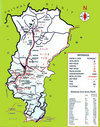Shah Jahan
¤ Shah Jahan-The Favorite Grandson of Emperor Akbar
The scene of history shifts to Delhi again with Shah Jahan (of the
Taj Mahal fame), the son of Jahangir ascending the throne. Shah Jahan
was the grand old emperor Akbar’s favorite grandson. In fact, at
one time there was a genuine fear that the sovereign would name him,
instead of his son, as the successor. This was largely because Akbar
regarded Jahangir as a bit of a bounder who whiled away his time with
wine and women from a startlingly young age. One of the most famous
movies in Indian cinematic history is Mughal-e-Azam (a must-see)
which, if you take away the romantic trimmings, is all about Akbar
saving Jahangir from his romantic excesses.
¤ Shah Jahan's Strain Relations With His Father Jahangir
Jahangir got a taste of his own medicine when he was king and his son
Shah Jahan (then Prince Khurram) revolted against him. Jahangir had to
eventually resort to the extreme measure of kidnapping his own
grandchildren away to Kashmir with him to shut his son up. What drove
Shah Jahan further away from his father was the intense court intrigue
with the calculating Nur Jahan at the hub. Jahangir, while being every
inch an autocrat, was completely dependent on his extremely capable
and shrewd wife, Nur Jahan. The queen had a daughter from a previous
marriage, and she wanted to see her daughter’s husband safely to
the throne. Nur Jahan, who could not have expected to win any
popularity contests in Agra, went alone in this choice. A major chunk
of the nobility was with Shah Jahan. However it was she who had, as
they say, the king’s ear. So despite the fact that Jahangir
agreed to forgive and forget Shah Jahan’s misadventures in 1625,
the tension could not be defused entirely.
¤ Shah Jhan Chosen As A Successor of The Throne
When Jahangir died in 1627 in Lahore, the Queen tried all the tricks
in the book to put her candidate on the throne. But it was all in
vain. Shah Jahan ascended the throne on popular demand, Nur Jahan
retired from public life and her son-in-law was imprisoned.
¤ The Golden Period of The Mughal Dynasty.
The reign of Shah Jahan has been widely acclaimed as the golden
period of the Mughal dynasty. There are many reasons for this. Thanks
to the firm base left by his grandfather and father, Shah Jahan’s
reign was relatively peaceful and hence prosperous. Except for a
drought in 1630, in the areas of Deccan, Gujarat and Khandesh, the
kingdom was secure and free from poverty. The coffers of the state
were brimming with the right stuff. So it’s no wonder that Shah
Jahan was the greatest and most assiduous builder of the Mughal
dynasty.
¤ Shah Jhan- Undoubtedly A Great King
In 1639, he decided to shift his capital to Delhi and construct a new
city on the banks of the Yamuna, near Ferozabad. It was to be called
Shahjahanabad. Work on the fort and city commenced in 1639 and it took
10 years to build the Red Fort and palace. The spectacular peacock
throne (the one that Nadir Shah took away) was transferred from Agra
to the Red Fort, the new seat of the Mughal rulers, on April 8, 1648.
Jahangir had built a great reputation for himself as a dispenser of
justice and Shah Jahan carried forward the good work and took a
personal interest in the judiciary. He demanded a high standard of law
and order and even petty thieves were not spared. The age was pretty
dynamic in the sense that there was intense interaction with foreign
countries and travellers poured into India from Persia, France, Italy,
Portugal and England. Which is very interesting for the scholar, for
one gets accounts of people from myriad nationalities during the Shah
Jahan’s reign.
Shah Jahan was undoubtedly a great king. He had shown evidence of
being a great general even under his father’s reign. Military
genius apart, his capacity for hard work is also legendary. A good
administrator, he saw to it that the government machinery moved on
oiled wheels. Within a year of his becoming king, the revenue of the
state had shot up meteorically.
¤ The Breathtaking Constructions of Taj Mahal
Shah Jahan was an aesthete and loved building. His greatest
achievements of course were the breathtaking Taj Mahal, which he built
in the memory of his wife Mumtaz Mahal, and the magnificent city of
Shahjahanabad, which remained the capital of India till well into the
19th century.
There was a downside, of course. He was a bigoted Muslim and a
confirmed nepotist. He provided for the imperial princes before anyone
else in the matter of administrative and judicial postings regardless
of age, capability and talent. He also started the practise of
bestowing each prince with an important office. For instance, Dara
Shikoh was made the governor of Punjab and Multan while Aurangzeb was
appointed governor of all the four provinces of the Deccan. This might
have just been a clever way to keep them occupied but that was not how
the nobility saw it. The nobles viewed the practice as an obstacle in
the path of their prosperity and promotions.
¤ Emperor's Devin Love For His Wife Mumtaz Mahal
It is said that Shah Jahan died in spirit the day his Queen Mumtaz
died. Stories are told of how he shut himself up in a room after her
death and when he came out next morning his hair had turned white. A
nice romantic tale, but the truth is that for all his love, Shah Jahan
did not hesitate to expose Mumtaz to the rigours of travel in all
states of health so that she died at the young age of 39 after giving
birth to their fourteenth child. Also he was quick to seek consolation
elsewhere and married several other women after Mumtaz died. However
the love for Mumtaz must have been enduring, for when he was old and
dying he began missing his queen all over again. By that time however,
the power equation had changed once again.
¤ The Peacock Throne
The fantastic Peacock Throne of the Mughals is now only a blurred
memory in the collective imagination of Indians. It is now only
alluded to illustrate the splendour and riches of India and all our
lost glory. Painstakingly created by skilled craftsmen and artisans
between 1628 and 1635, it was carried away to Persia by the marauding
Nadir Shah in 1739. There are however still some miniature paintings
that depict Akbar and Jahangir sitting proud on it. Shaped as a golden
bedstead with golden legs and an enamelled canopy supported by 12
pillars, it looks breathtakingly fabulous. Each of the 12 emerald
pillars bore two peacocks encrusted with gems and a tree with
diamonds, emeralds, rubies and pearls nestled between each pair of
birds. Just look at the picture - can you guess how much it cost?
A whopping 10 million rupees, equivalent then to a million and
quarter pound sterling.
























































